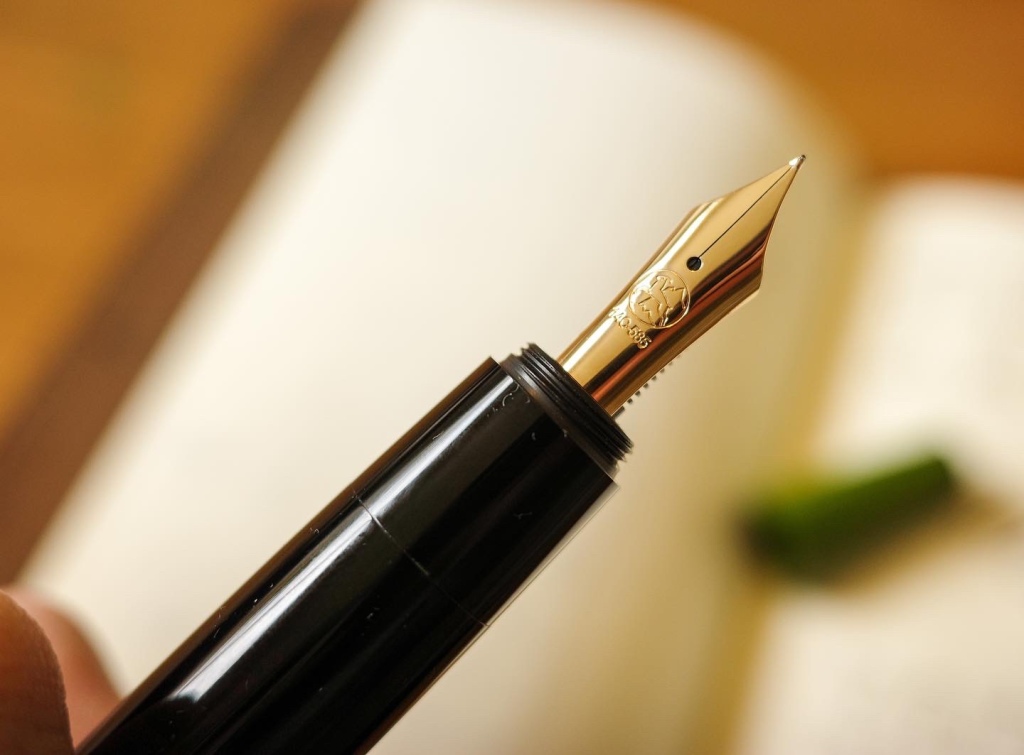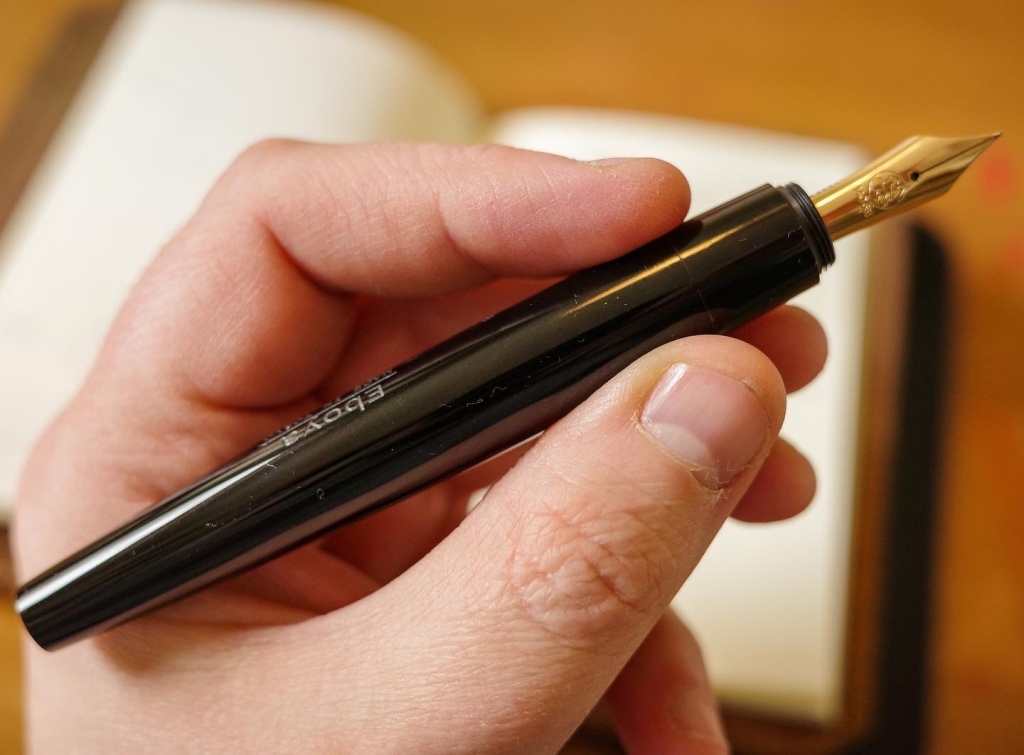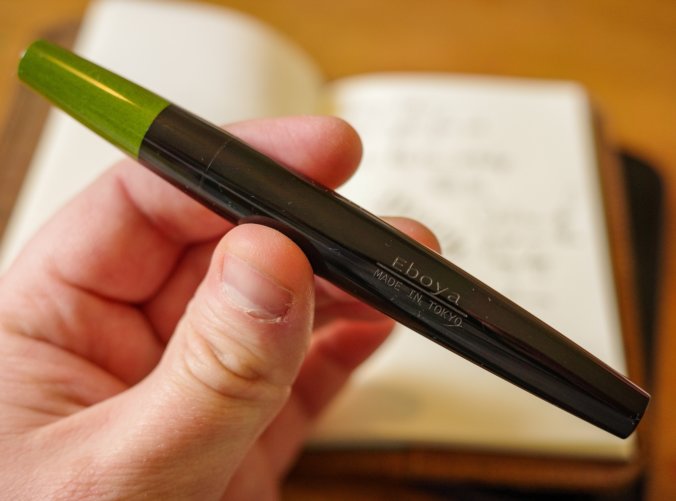There’s not a lot of talk in the English-speaking pen world about Tokyo-based manufacturer Eboya, and even less about its ‘Flute’ design, the Kobue, which is a special edition model originally created for pen shows. Although you can buy Eboya pens from retailers like Inktraveler and Sakura, as far as I know the Kobue is only available direct from the manufacturer.
I posted about it last year, and the order I placed for one in November arrived this week. I wanted to share some key facts if this pen has landed on your radar as a potential purchase.
The Kobue is a solid ebonite pen — you’d expect nothing less from Eboya, which is part of the Nikko ebonite company. There’s no metal at all in the construction (aside from the nib, obviously), which means it can be safely eyedroppered.

This is a short-cap design, rather like the Tesori Venezia I reviewed a while back. This means the Kobue is deceptively small when capped, but it retains almost all of its length when uncapped. See the comparison below against the Lamy 2000.


The tiny cap posts deeply, adding almost no weight to the back of the barrel.

Aesthetically, it’s a pretty little thing. The barrel and section are glossy black ebonite, with the cap in matcha green so it stands out. The ends are almost flat, there’s no clip, and there’s a symmetrical taper to each end of the pen. The only branding is an engraving of “Eboya Made in Tokyo” on the barrel, which is very subtle.

The finish is very good. The ebonite takes an excellent polish. The join between barrel and section, and between cap and section, are visible and you can feel them under your fingertips, but they’re almost seamless, giving a very streamlined look to the Kobue.
The cap threads take 1.25 turns. The cap stays on securely, and Eboya have engineered these threads well: there’s no cross-threading at all (not always a given when there’s no barrel length to help you align the threads properly). The threads and the lip behind them are sharp, but because they’re right on the end of the barrel, it’s almost impossible to touch them in normal use.
Unusually, Eboya uses German Bock nibs in its pens, and ships the Kobue with a single blue Pelikan cartridge. A converter will fit, I think. I picked a fine nib, which is 14k gold, gold single coloured, and one of Bock’s slightly smaller sizes. It looks proportionate to the pen, and has a plastic feed — a missed opportunity for Eboya to show off its skills with ebonite.

The nib writes nicely with some bounce and a true fine line, although in my limited use so far it seems to hard start at the beginning of words just enough to be noticeable. It probably needs some flushing.
Hand comfort is excellent. The ebonite is silky and warm, plenty grippy enough. The Kobue is a light pen and the weight is concentrated at the nib end. After removing the cap, you end up gripping the pen by its widest points, ranging from 13mm diameter right by the nib, to 15mm diameter at the middle of the barrel.

The Kobue is 43,000 yen shipped, which translated to about £285, plus I was hit with about £75 import duties. This makes the purchase about £360 overall. That’s a lot of money, obviously, putting the Kobue up against pens like the Pelikan M800 and Aurora Optima, or the Lamy 2000 which shares some of its aesthetics. But as you’ll see when you try to buy a Kobue, they’re not easy to get hold of:

I like the Kobue, and indeed I like what Eboya does generally. Ebonite is a great material for fountain pens, and when you shape it into a clean, compact and ergonomic shape like the Kobue, you end up with a great pen for writing. Although this is a simple design, without a lot of ostentatious flourishes, you know it’s been made by a small team of craftspeople, and the eccentric green cap brings a bit of fun to the design. I’m glad I took the leap and ordered one while I had the opportunity.

Thanks for this review and your first impressions, Anthony. I’ve had my eye on an Eboya Hakobune for quite a while now. Like you, it’s hard to find much information about the pen, but the reviews that I have seen are generally quite positive. Still, it’s hard to get a sense of scale with the S-M-L sizing of the other pens and I agree that it would be a nice touch if they showed off a bit with an ebonite feed or Japanese eyedropper mechanism. The Kobue is certainly a nice pen, though. Glad to hear that you are enjoying it!
Thanks for this review. Eboya has been on my radar for some time now, but it seems there is always a wait of indeterminate length to get one. And while I understand Sakura and a few others have to price up as retailers, many of Eboya’s pens are somewhat cheaper ordered directly from their website. Not that any of those prices are modest either!
The Japanese design esthetic greatly appeals to me. Its best expression embodies the audacity of simplicity. The Eboya Kobue is a perfect example, but as you pointed out, an ebonite feed would make it even better.
The Japanese appreciate ebonite greatly, and I can understand why, because I appreciate it too. It is warm and has an almost organic feel in the hand, quite unlike acrylic and metal pens. I have those as well, but I like the contrast ebonite presents. And ebonite itself can be fashioned in many different colors that may have an entirely different look from acrylic colors. It can be left matte or polished and that changes the look and feel also.
I hope you come to enjoy your Kobue even more with the passage of time.